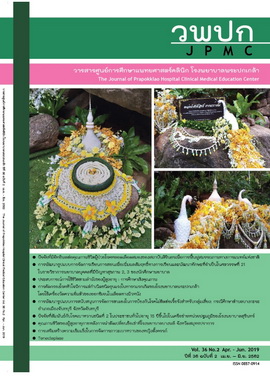Critical Congenital Heart Disease Screening in Neonates in Prapokklao hospital
Main Article Content
Abstract
Background: Critical congenital heart disease is congenital heart disease which requires urgent surgery or cardiac catheterization within 1-2 months after birth, otherwise it might cause complications to patients leading to morbidity and mortality. Therefore, the early diagnosis will reduce the morbidity and mortality for these patients. At present, some countries are using a pulse oximeter for the basic screening for critical congenital heart disease in newborns. However, Thailand has not yet implemented its universal use.
Objective: To study the sensitivity, specificity, and accuracy of the pulse oximeter in screening for critical congenital heart disease in order to use the pulse oximeter as a method for basic screening at Prapokklao Hospital’s nursery.
Meterials and method: Cross-sectional study. We included all newborns from April 1, 2017 to April 30, 2018. Screening of oxygen saturation on all newborns was performed. Physical examinations and pulse oximeter screenings were performed on newborns after 24 hours of life but before 48 hours. An echocardiogram was used as a confirmation test in positive screening cases.
Results: There was no critical congenital heart disease from the screening of 3,541 infants in this study. Six cases of critical congenital heart disease were excluded from the study due to presentation of signs and symptoms at age less than 24 hours. The incidence of critical congenital heart disease is 1.69 among 1,000 live births.
Conclusion: The result of this study suggests it is not practical to do the screening in Prapokklao Hospital because there were no cases of critical congenital heart disease found in this screening. This may happen due to the signs and symptoms of critical congenital heart disease being found and diagnosed before 24 hours of age and also due to the small sample size used. To further researchers, we recommend including more infants aged less than 24 hours and increasing the sample size.
Article Details
References
Abu-Harb M, Hey E, Wren C. Death in infancy from unrecognised congenital heart disease.Arch Dis Child 1994;71:3-7.
Kuehl KS, Loffre do CA, Ferencz C. Failure to diagnose congenital heart disease in infancy.Pediatrics1999;103:743-7.
Stevenson DK, Benitz WE.A practical approach to diagnosis and immediate care of the cyanotic neonate.Stabilizationand preparation for transfer to level III nursery.ClinPediatr (Phila) 1987;26:325-31.
Ainsworth SB, Wyllie JP, Wren C.Prevalence and clinical significance of cardiac murmurs in neonates. Arch Dis Child Fetal Neonatal Ed 1999;80:F43-5.
Brown KL, Ridout DA, HoskoteA, Verhulst L, Ricci M, Bull C. Delayed diagnosis of congenital heart disease worsens preoperative condition and outcome of surgery in neonate. Heart 2006;92:1298-302.
Henprasertthae S, Chaonarin P. Screening for critical congenital heart disease in Thai Neonates: single center study. ThaiJPediatr2013;52:242-9.
Richmond S, Reay G, AbuHarb M. Routinepulseoximetry in the asymptomaticnewborn. Arch Dis Child Fetal Neonatal Ed 2002;87:83-8.
Richmond S, Wren C. Early diagnosis of congenital heart disease.SeminNeonatol2001;6:27-35.
Riede FT, Wörner C, Dähnert I, Möckel A, Kostelka M, Schneider P. Effectiveness of neonatal pulse oximetryscreening for detection of critical congenital heart disease in daily clinical routine-- results from a prospective multicenter study. Eur J Pediatr2010;169:975-81.
Brown KL, Ridout DA, HoskoteA, VerhulstL,RicciM,Bull C. Delayed diagnosis of congenital heart disease worsens preoperative condition and outcome of surgery in neonates. Heart 2006;92: 1298–302.
Hoke TR, Donohue PK, Bawa PK, Mitchell RD, Pathak A, Rowe PC, et al. Oxygen saturationas a screening test for critical congenital heart disease: a preliminary study. PediatrCardiol2002;23:403-9.
Reich JD, Miller S, Brogdon B, Casatelli J, Gompf TC, Huhta JC, et al. The use of pulseoximetry to detect congenital heart disease. J Pediatr2003;142:268-72.
de-Wahl Granelli A, Wennergren M, SandbergK,Mellander M, Bejlum C, Inganäs L, et al. Impact of pulse oximetry screening on the detection of duct dependent congenital heart disease: a Swedish prospective screening study in 39 821 newborns. BMJ 2009;338:a3037.
Dorfman AT, Marino BS, Wernovsky G, Tabbutt S, Ravishankar C, Godinez RI, et al. Criticalheart disease in the neonate: presentation and outcome at a tertiary care center. PediatrCrit Care Med 2008; 9:193-202.
Schultz AH, Localio AR, Clark BJ, Ravishankar C, Videon N, Kimmel SE. Epidemiologicfeatures of the presentation of critical congenital heart disease: implications for screening.Pediatrics2008 Apr ;121:751-7.
Liske MR, Greeley CS, Law DJ, Reich JD, Morrow WR, Baldwin HS, et al. Report of thetennessee task force on screening newborn infants for critical congenital heart disease. Pediatrics [Internet]. 2006 [cited 2018 Sep 22]; 118(4):e1250-6. Available from: https://pediatrics-aappublications-org.cuml1.md.chula.ac.th/content/pediatrics/118/4/e1250.full-text.pdf
Layangool T. Critical congenital heartdisease screening in neonates in Thailand.5th Congress of the Asia Pacific PediatricCardiac Society, 2014 March 6-9; India; 2014.
Hoffman JI, Kaplan S. The incidence of congenital heart disease. J Am CollCardiol 2002; 39:1890–900.

